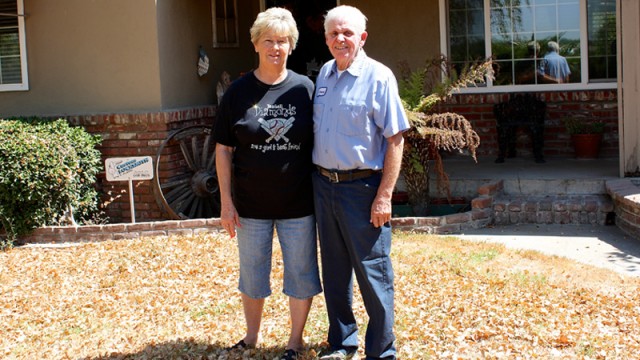“We’re very water-conscious. We have been all these years,” says Vieira.
But now, their kids and grandkids can’t even stay overnight because there’s not enough water. The Vieiras have let their lawn die, let their gardener go.
“I have artificial flowers by my front door. And I hate artificial flowers. But, for a little bit of color,” says Vieira, who takes me on a tour of her dead front lawn.
She’s trying to save her grandmother’s 100-year-old hydrangea -- and her great-grandmother’s even older geranium -- by collecting the water she uses to bathe and pouring it into the pots.
“This is my grandmother’s, and it’s just burned and dying,” she says, fingering the dry petals. “But I think it will make it through. What i’m concerned about is, are we going to make it through?”
The Vieiras ran an auto repair shop for many years. Now they’re retired and have nowhere near the $20,000 it would take to drill a new well.
“My husband’s 75 and I’m 70. We live on a fixed income," says Vieira. "We’re not asking for a handout. We just need help."
But the Vieiras have slipped through the safety net. The state provides drought assistance to small, rural community water systems, but not for private property owners who rely on their own wells.
“No one has thought about domestic well owners,” says Vieira. “Which is a real shame, because there’s thousands of us, and water is a necessity. You have to have it to live.”
The USDA offers some limited federal grants and loans for extremely low-income individuals with water wells, but nothing for middle-class folks.
“ ’Cuz if you’re super rich, you got the money. If you’re super poor, you qualify for the grants. But we’re in between. We’re the middle class, and now we’re old!” Vieira laughs.
That’s exactly the population Stanislaus County is trying to help.
“Water is such a basic necessity of life,” says Stanislaus County Supervisor Bill O’Brien. “Someone doesn’t have water, can’t get a new well, you know, we feel there’s a moral obligation to step in and do something to help ‘em. “
O’Brien and his colleagues -- who are all fiscal conservatives -- unanimously decided to dig into county coffers to set up a program to help people whose wells are going dry.
O'Brien says this is not a handout. It’s a loan to be paid back with interest -- at a very attractive 1 percent interest rate. Loan applicants have to put liens on their homes to qualify.
“The taxpayer is protected. And that’s why I think you saw a conservative Board of Supervisors approve this program,” says O’Brien.
The money comes from a county economic development bank fund. And O’Brien says this project fits that mission.
“It’s really to fund things to spur the economy. If someone doesn’t have water, that’s part of the economy as well. If they have to move out of county, they’re not spending money at the local businesses,” he explains.
The pilot phase allots only $200,000, which will pay for loans to dig only about 10 wells. No one knows for sure how many wells are going dry in the county, but O’Brien estimates about 100,000 people -- a fifth of Stanislaus County’s population -- rely on domestic wells.
Still, Noe Paramo of California Rural Legal Assistance Foundation says he’s glad to see the supervisors stepping up to provide a local safety net.
“This critical issue of groundwater depletion has hit home. And it’s affecting their constituents, who vote with their feet,” says Paramo.
But he wants to make sure less vocal residents, such as Spanish speakers or those without Internet access, will also be able to apply for loans.
Paramo also notes that county supervisors delicately avoided the issue of whether all the new wells drilled on profitable almond farms in the county may be responsible for sucking down the groundwater.
“The crop has gone through the roof. You read it in the paper, how much money they’re making," he said. "Even if they don’t acknowledge that they are responsible for depleting it, they should be good stewards and good neighbors and help neighbors out.”
His idea: have farmers set up a fund to help their residential neighbors drill household wells, so the county isn’t the only one lending a hand. But that idea is pretty unlikely to fly with growers.
